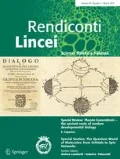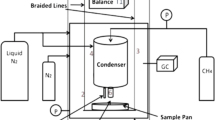Abstract
Some aspects of Titan’s organic chemistry are considered with particular emphasis on possible surface processing of organic species made in Titan’s upper atmosphere. Sources of energy include solar ultraviolet radiation, charged particles from the Saturnian magnetosphere, cosmic rays, winds and rain, hypervelocity impacts and (putatively) melting of crustal water ice (cryovolcanism). All of these sources, even those for which the energy is absorbed in the upper atmosphere, affect the surface, either directly or through the deposition of chemically reactive species sedimented out of the atmosphere in the form of aerosols. Once on the surface, organic molecules are immersed in a variety of different environments including dunes, mountains, river valleys, lakes and seas, which will affect the nature and outcome of chemical processes. All of the liquids in these environments are the light alkanes: methane, ethane, and propane. The organic chemistry ongoing in the surface system, should it be accessible for study, would provide an object lesson in the extent to which planetary environments drive or inhibit chemical complexity, with obvious application to the prebiotic Earth.



Similar content being viewed by others
References
Aharonson O, Hayes AG, Lunine JI, Lorenz RD, Allison MD, Elachi C (2009) An asymmetric distribution of lakes on Titan as a possible consequence of orbital forcing. Nature Geoscience 2:851–854
Bernard J-M (2004) Simulation expérimentale de la chimie atmosphérique de Titan. Thesis, Universite Paris 7
Brown RH, Lebreton J-P, Waite JH (eds) (2009) Titan from Cassini-Huygens. Springer, Dordrecht
Clark RN, Curchin JM, Barnes JW, Jaumann R, Soderblom L, Cruikshank DP, Brown RH, Rodriguez S, Lunine J, Stephan K, Hoefen TM, Le Mouelic S, Sotin C, Baines KH, Buratti BJ, Nicholson PD (2010) Detection and mapping of hydrocarbon deposits on Titan. J Geophys Res 115:E10005
Cordier D, Mousis O, Lunine JI, Lavvas P, Vuitton V (2009) An estimate of the chemical composition of Titan’s lakes. Astrophys J 707:L128–L131
FAO (2005) Energy conversion by photosynthetic organisms. Food and Agricultural Organization of the United Nations. http://www.fao.org/docrep/w7241e/w7241e06.htm#TopOfPage
Hörst SM, Yelle RV, Buch A, Carrasco N, Cernogora N, Dutuit O, Quirico E, Sciamma-O’Brien E, Smith MA, Somogyi A, Szopa C, Thissen R, Vuitton V (2010) Formation of amino acids and nucleotide bases in a Titan atmosphere simulation experiment. Bull Am Astron Soc 42: p. 1068, abstr. 36.20
Hueso R, Sanchez-Lavega A (2006) Methane storms on Saturn’s moon Titan. Nature 442:428–431
Lavvas P, Coustenis A, Vardavas I-P (2008) Coupling photochemistry with haze formation in Titan’s atmosphere, Part II: results and validation with Cassini/Huygens data. Planet Space Sci 56:67–99
Lorenz RD, Mitchell KL, Kirk RL, Hayes AG, Aharonson A, Zebker H, Paillou P, Radebaugh J, Lunine JI, Janssen M, Wall SD, Lopes RM, Stiles B, Ostro S, Mitri G, Stofan ER (2008) Titan’s inventory of organic surface materials. Geophys Res Lett 35:L02206
Lorenz RD, Newman C, Lunine JI (2010) Threshold of wave generation on Titan’s lakes and seas: Effect of viscosity and implications for Cassini observations. Icarus 207:932–937
Lunine JI, Choukron M, Stevenson DJ, Tobie G (2009) The origin and evolution of Titan. In: Brown RH, Lebreton JP, Waite H (eds) Titan from Cassini-Huygens. Springer, Dordrecht, pp 35–59
Lunine J, Artemieva N, Tobie G (2010) Impact cratering on Titan: hydrocarbons versus water. LPSC 41: abstr. 1533
Lunine J, Reh K, Sotin C, Couzin P, Vargas A (2011) Titan aerial explorer: a mission to circumnavigate Titan. LPSC 42: abstr. 1230
Matteson DS (1983) Acetylene on Titan. Science 223:1131
McKay CP, Smith H (2005) Possibilities for methanogenic life in liquid methane on the surface of Titan. Icarus 178:274–276
Mitri G, Showman AP, Lunine JI, Lopes RMC (2008) Resurfacing of Titan by ammonia–water cryomagma. Icarus 196:216–224
Neish C, Somogyi A, Smith MA (2010) Titan’s primordial soup: Formation of amino acids via low-temperature hydrolysis of tholins. Astrobiology 10:337–347
Niemann HB, Atreya SK, Demick JE, Gautier D, Haberman JA, Harpold DN, Kasprzak WT, Lunine JI, Owen TC, Raulin F (2010) Composition of Titan’s lower atmosphere and simple surface volatiles as measured by the Cassini Huygens probe gas chromatograph mass spectrometer experiment. J Geophys Res 115:E12006
Nimmo F, Bills BG (2010) Shell thickness variations and the long-wavelength topography of Titan. Icarus 208:896–904
Ramirez SI, Coll P, Buch A, Brassé C, Poch O, Raulin F (2010) The fate of aerosols on the surface of Titan. Faraday Discuss 147:419–427
Raulin F, Hand KP, McKay CP, Viso M (2010) Exobiology and planetary protection of icy moons. Space Science Reviews 153:511–535
Stofan E, Lorenz RD, Lunine JI, Aharanson O, Bierhaus E, Clark B, Griffith C, Harri A-M, Karkoschka E, Kirk R, Kantsiper B, Mahaffy P, Newman C, Ravine M, Trainer M, Waite JH, Zarnecki J (2010) Titan Mare Explorer: First in situ exploration of an extraterrestrial sea. Astrobiology Science Conf., League City,TX. Abstr. 5270
Tomasko MG, Archinal B, Becker T, Bézard B, Bushroe M, Combes M, Cook D, Coustenis A, de Bergh C, Dafoe LE, Doose L, Douté S, Eibl A, Engel S, Gliem F, Grieger B, Holso K, Howington-Kraus E, Karkoschka E, Keller HU, Kirk R, Kramm R, Küppers M, Lanagan P, Lellouch E, Lemmon M, Lunine JI, McFarlane E, Moores J, Prout GM, Rizk B, Rosiek M, Rueffer P, Schröder SE, Schmitt B, See C, Smith P, Soderblom L, Thomas N, West RA (2005) Rain, winds and haze during the Huygens probe’s descent to Titan’s surface. Nature 438:765–778
Turtle EP, Perry JE, Hayes AE, Lorenz RD, Barnes JW, McEwen AS, West RA, Del Genio AD, Barbara JM, Lunine JI, Schaller EL, Ray TL, Lopes RMC, Stofan ER (2011) Rapid and extensive surface changes near Titan’s equator: Evidence of April showers. Science in press
Wood CA, Lorenz R, Kirk R, Lopes R, Mitchell K, Stofan E, the Cassini Radar team et al (2010) Impact craters on Titan. Icarus 206:334–344
Yung YL, Allen MA, Pinto JP (1984) Photochemistry of the atmosphere of Titan: Comparison between models and observations. Ap J Suppl 55:465–506
Zhou L, Zheng W, Kaiser R, Landera A, Mebel AM, Liang M-C, Yung YL (2010) Cosmic-ray-mediated formation of benzene on the surface of Saturn’s moon Titan. Ap J 718:1243–1251
Acknowledgments
We are grateful to Dr. Francois Raulin for his comments, which improved the manuscript. This work was financed within the scope of the program “Incentivazione alla mobilita’ di studiosi straineri e italiani residenti all’estero.”
Author information
Authors and Affiliations
Corresponding author
Rights and permissions
About this article
Cite this article
Lunine, J.I., Hörst, S.M. Organic chemistry on the surface of Titan. Rend. Fis. Acc. Lincei 22, 183–189 (2011). https://doi.org/10.1007/s12210-011-0130-8
Received:
Accepted:
Published:
Issue Date:
DOI: https://doi.org/10.1007/s12210-011-0130-8



